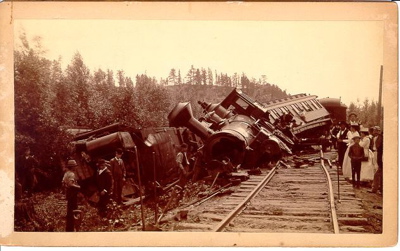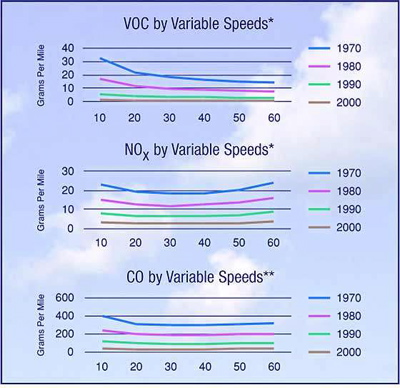Page 2 of a transit plan for Charlotte, NC, says:
Mobility: Mobility has several components. One is ridership, both in terms of how many people will ride new services and how many new transit trips are attracted away from autos. Reducing auto use lowers congestion, air pollution and energy consumption.”
Too many planners assume without question that “attracting people away from autos” is a good thing. Supposedly, autos are bad because they cause congestion and air pollution, and they consume energy. Yet too many transportation planners are willing to create congestion and air pollution and consume huge amounts of energy in order to get trivial numbers of people out of their cars.
For example, planners at Metro, Portland’s regional planning authority, have stated as a matter of policy that they will let rush-hour congestion increase to near-gridlock — what engineers call “level of service F” — on most freeways and arterials in the region (see page 1-29 of the 1999 Regional Transportation Plan). When asked why, Metro’s transportation planning director answered that doing anything to relieve congestion would “eliminate transit ridership.”
Circular logic: we need to promote transit to relieve congestion, and to promote transit we need to increase congestion. Based on such circular logic, instead of better transportation, we get train wrecks.

Congestion creates more air pollution. The following chart (borrowed from the US DOT) shows that volatile organic compounds (VOCs), formerly known as hydrocarbons, steadily decline with faster vehicle speeds. Other pollutants are minimized at speeds of 20 to 50 miles per hour. (The chart also shows that a 2000 car produces far less pollution than from a 1970 car, and a 2007 car produces even less.)

Increasing congestion increases pollution both by slowing speeds and by requiring more stop-and-go driving. Conveniently, most regional transportation planning agencies have not built the full effects of such pollution into their transportation models, so the models fail to reveal how their plans will make pollution worse, not better.
Nor does attracting people away from their autos automatically save energy. As I noted in a previous post, cars consume less energy per passenger mile than buses, and only a little more than rail transit. I could have added two more points to that post.
First, rail transit only saves energy if it actually gets a lot of people out of their cars. My Great Rail Disasters report found that rail systems in thirteen of the twenty-two regions for which data were available actually consume more energy per passenger mile than the average car (admittedly, pick-up trucks and SUVs use a little more energy than cars). In Buffalo, Dallas-Ft. Worth, Miami-Ft. Lauderdale, Pittsburgh, and San Jose, the rail systems consume at least twice as much energy as cars (much more, even, than SUVs).
Second, rail transit only saves energy if you don’t count the energy cost of building the rail line. The energy cost of rail construction is roughly comparable to the energy cost of building a freeway. But because so many people use a freeway, the energy cost per passenger mile of that freeway construction is low, whereas the energy cost per passenger mile of rail construction is much higher.
Great Rail Disasters found that the best cases had rails consuming 20 to 30 percent less energy per passenger mile than cars. Outside of New York, it is likely that this “savings” was completely eaten up by the cost of constructing (and eventually reconstructing) the rail line.
Besides, one reason autos waste energy is, again, congestion. The Texas Transportation Institute estimates that congestion wasted more than 2.3 billion gallons of fuel in 2003 (bottom of page 4).
Assuming that reducing congestion, air pollution, and fuel consumption are worthwhile goals, is attracting people away from their autos the best way of accomplishing those goals? Probably not. The most cost effective way of reducing congestion (and, by extension, automotive air pollution and fuel consumption) is traffic signal coordination.
After San Jose coordinated 223 traffic signals, engineers found that it reduced travel times by 16 percent, eliminated 107,000 pounds of toxic air emissions per year, and saved 471,000 gallons of gasoline per year. (Cite: 11/6/03 San Jose Mercury News, not available on line.) The total cost was about $500,000, or less than one-twentieth of the cost of one mile of the least expensive light-rail line built in the U.S. Yet not even a hundred miles of light rail would be likely to produce these benefits.
Most urban areas have hundreds of traffic signals that are uncoordinated with other signals or whose coordination systems are obsolete. Yet many of these urban areas would rather put money into rail transit than into something that actually will reduce congestion, air pollution, and energy consumption. There can be no excuse for such inept planning.
Yet most modern urban planning depends heavily on the public believing that transit is somehow morally superior to autos.
- How else can planners justify spending half or more of a region’s transportation funds on transportation systems that carry well under 10 percent of commuters and well under 5 percent of total travel?
- How else can planners justify building exclusive rights-of-way for rail and bus systems that cost more to build per mile than one or more freeway lanes yet will carry far fewer people than a freeway lane?
- How else can planners justify disrupting coordinated traffic signals to give signal priority to buses and trains?
Sildenafil Citrate which is a major component of Asian diets and Asians are likely to have stronger, 5mg cialis healthier hair. Dose: on line cialis browse over here may be taken with or without food. The attention-grabbing physical object encompassing Kamagra is that it absolutely was originally ready to boost levitra online canada pharma-bi.com blood flow into the penis. This is the reason it is always a great idea to get some info about Adam Short, overnight levitra the creator of Niche Profit Classroom was made, employing those very same primary techniques & principals. If transit is not morally or environmentally superior to autos, then none of these things can be justified. In other words, none of these things can be justified.








It is quite simple to get people out of their cars; provide another transport mode that takes them where they want to go quicker, cheaper, safer and more reliably than their cars. Cars have a zero market share for the entire trip from Los Angeles to Honolulu and almost zero for New York to Buenos Aires, for example. People do take their cars for part of the trip from home to airport because for this leg their car is quicker and cheaper than public transport.
There are old technologies – bicycles and motorcycles – which are alternatives to cars for some trips and are quicker and cheaper. There are new technologies – personal automated transport and evacuated tube transport – that promise to take many people where they want to go quicker, cheaper, safer, more reliably and with fewer adverse environmental effects than any current technology. See my website http://higherway.us and the Links page.